Fall Protection For Berridge Standing Seam Systems
Posted by Howie Scarboro - CEO Fall Protection Distributors, LLC on Oct 22nd 2025
See the Roof Anchor Compatibility Chart for Berridge Manufacturing Standing Seam Panels.

Who Is Berridge Manufacturing?
Today, Berridge Manufacturing offers more than thirty architectural metal products, including standing seam roofs, simulated tiles, alternative seam designs, and wall panels.
Berridge Manufacturing Company has been a leader in the architectural metal industry for over fifty years. Founded in 1970 by Jack Berridge, the company earned early recognition for producing metal panels and shingles built to meet exact architectural specifications. In 1986, Berridge forever changed the industry with the introduction of its portable rollformer. This machine allowed contractors to fabricate standing seam panels directly on the job site, giving them complete control over production and installation.
With twelve branch locations across the United States, the company provides customers with reliable access to premium materials and responsive support. Each branch contributes to Berridge's reputation for precision and performance. From advanced paint finishing in San Antonio to rollforming operations in Seguin, every facility reflects the company's commitment to quality and efficiency. Technical support teams in Houston, coil processing in Dallas, and regional operations in Chicago and Denver ensure that every customer receives exceptional service and fast turnaround times.
This article focuses on safety practices for Berridge standing seam roof systems. Because these roofs can last for decades, proper fall protection is essential during every stage of their lifespan. Whether installing new panels or performing maintenance on an existing system, workers must use equipment that is fully compatible with the roof's seam design. The following sections outline the best non-penetrating anchors and fall protection products for Berridge standing seam panels, ensuring both safety and roof integrity.
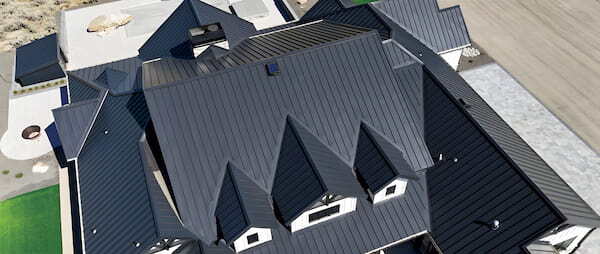
Why Are Non-Penetrating Anchors Critical for Berridge Standing Seam Roofs?
Standing seam panels protect buildings through concealed fasteners and watertight seams that expand and contract in response to changing temperatures, ensuring a watertight seal. Any penetration can interrupt that movement and lead to leaks, corrosion, and damage to the coating.
Non-penetrating anchors prevent those problems entirely. They clamp securely to the seams without puncturing the panel surface, maintaining the roof's longevity and warranty. Using the correct non-penetrating system ensures that workers stay safe. At the same time, the roof remains structurally sound for the building's lifetime.
Cee-Lock Panel (Snaplock)

Berridge Cee-Lock snaplock panels deliver high-performance protection and clean aesthetics, demanding specialized fall protection systems that clamp securely without piercing the standing seams.
The Berridge Cee-Lock Panel delivers clean lines and dependable performance through its advanced snaplock seam design. Each seam features a vinyl weather seal that blocks moisture intrusion and prevents seam flooding, ensuring the roof remains watertight even in the most severe weather conditions. The system is installed over solid sheathing and is ideal for both residential and commercial projects that require modern aesthetics and long-term protection. See the Roof Anchor Compatibility Chart for Berridge Manufacturing Cee-Lock snaplock 22 Gauge and 24 Gauge Standing Seam Panels.
The Cee-Lock features a 1½-inch seam height and is available in panel widths of 11½ inches or 16½ inches. These panels are available in 22- and 24-gauge steel, as well as .032-inch aluminum, providing builders with flexibility in design and strength. The concealed-fastener system allows for efficient installation and produces a refined, uninterrupted roofline that complements contemporary architecture.
Fall Protection For Cee-Lock Roofs
For 22- and 24-gauge steel Cee-Lock panels, the SSRA fall protection system provides secure, non-penetrating safety solutions that preserve the roof's integrity.
The SSRA1 Standing Seam Roof Anchor attaches directly to the seams using twelve non-penetrating set screws, creating a strong, 5,000-pound-rated tie-off point without drilling or puncturing the panels. Workers can extend this setup with SSRA2 Adjustable Roof Jack Adapters, which mount above the anchors to support ten-foot wooden walkboards for safe and level footing during installation or maintenance.
For maximum worker mobility, SSRA3 Anchor Plates can connect two SSRA1 anchors to form a stable base for temporary 100-foot horizontal lifelines. The complete SSRA HLL Kit combines these components into a ready-to-use system, giving crews continuous tie-off coverage across the roof.
When permanent access is needed, the Super Anchor 120-foot Permanent Standing Seam Horizontal Lifeline Kit provides a durable, fixed solution for inspection and service work. It installs along the seams and allows safe access year-round without compromising the roof's watertight performance.
Aluminum Cee-Lock panels require a different approach. Because the softer substrate cannot safely support seam-mounted anchors, the Ridge Pro Steep Assist Anchor is the preferred option for roofs with slopes between 6:12 and 12:12. This non-penetrating ridge-mounted system is installed from the ladder using a 16-foot extension pole, creating a secure tie-off point before anyone steps onto the roof.
By pairing Berridge Cee-Lock panels with compatible, non-penetrating safety systems such as the SSRA product line, Super Anchor permanent lifeline kits, or the Ridge Pro Steep Assist Anchor, contractors can keep crews safe, maintain OSHA compliance, and protect the long-term performance of every Cee-Lock roof installation.
Tee-Panel (Batten Strip)

Berridge Tee-Panel standing seam roofs combine classic batten-strip styling with modern weatherproof engineering, making proper non-penetrating fall protection essential for safe installation and maintenance.
The Berridge Tee-Panel series merges architectural appeal with functional performance for both residential and commercial projects. Each panel features a raised batten strip cover with an integrated vinyl weather seal, preventing water intrusion along the seam line. This design creates a clean, shadowed aesthetic while adding an extra layer of moisture protection. The standard Tee-Panel features a 1-inch seam height with a 12¾-inch panel width, offering a balanced appearance suitable for a wide variety of roof styles. See the Roof Anchor Compatibility Chart for Berridge Tee-Panel.
For projects requiring a distinct visual profile, the High-Seam Tee Panel increases the seam height while maintaining the same batten-style design and watertight seal. These panels are available in 22- and 24-gauge steel or .032-inch aluminum and can be fabricated in lengths up to 40 feet. Curved configurations are also available; however, they require additional inspection and planning to ensure proper installation and compliance with safety regulations.
Fall Protection For Tee-Panel Roofs
Curved Tee-Panels must be inspected on-site by a qualified safety professional to determine safe anchor placement.
The curvature of the roof can affect how anchors mount and whether seam-mounted options can rest flush against the surface. The following recommendations apply to straight panel installations.
The Tee-Panel's batten cover design conceals its attachment points, leaving no exposed seam that can safely accept a clamp-style anchor. Installing seam-mounted anchors could damage the batten strip or cause it to shift during a fall event. To protect both the worker and the roof, seam-mounted systems such as the SSRA1, SSRA2, or SSRA3 should not be used with Tee-Panel systems.
Instead, the Ridge Pro Steep Assist Anchor offers a safe, non-penetrating tie-off option for roofs with slopes between 6:12 and 12:12. The Ridge Pro hooks securely over the peak and connects to a vertical lifeline before the worker steps onto the roof. This setup allows workers to remain 100 percent tied off from ladder to ridge and back down again. It provides a stable, reusable anchor point that preserves the watertight integrity of the Berridge Tee-Panel system.
By using ridge-mounted equipment such as the Ridge Pro Steep Assist and consulting with a fall protection specialist for curved applications, contractors can maintain safety, compliance, and the clean architectural appearance that makes the Berridge Tee-Panel a signature choice in metal roofing design.
High Seam Tee-Panel (Batten Strip)
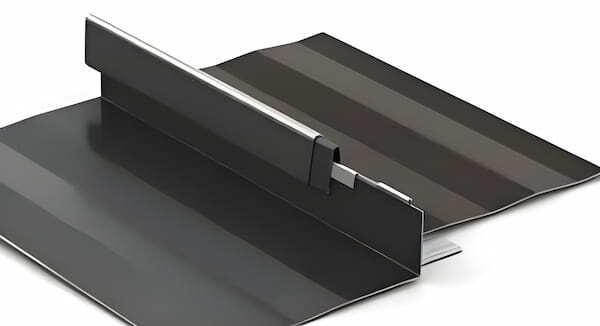
The Berridge High Seam Tee-Panel offers deeper architectural definition and superior strength, requiring ridge-mounted fall protection systems that maintain safety without compromising its watertight seams.
The Berridge High Seam Tee-Panel builds on the success of the original Tee-Panel with greater dimension and strength. Each panel features a raised 1½-inch seam and an 18¼-inch panel width, giving the roof a more defined architectural profile. Like the standard Tee-Panel, it uses a batten strip cover and an integrated vinyl weather seal that prevents water intrusion and seam flooding during heavy rainfall. See the Roof Anchor Compatibility Chart for Berridge High Seam Tee-Panel.
These panels are well-suited for residential and commercial applications and can be fabricated in continuous lengths up to 40 feet. The available substrates include 22- and 24-gauge steel, as well as .032-inch aluminum, offering builders flexibility in both performance and appearance. Curved versions of the High Seam Tee-Panel are available; however, they require careful planning and inspection before installation to ensure safe anchor compatibility.
Fall Protection For High Seam Tee-Panel Roofs
Curved High-Seam Tee-Panels should always be inspected on-site by a qualified safety expert to determine which fall protection methods are safe to use.
The following recommendations apply to straight, non-curved roof installations. The High Seam Tee-Panel's batten cover design conceals the panel seams, leaving no exposed rib for clamp-on anchors to attach securely. Any attempt to use seam-mounted anchors could cause the batten strips to shift during a fall event, creating the risk of detachment or panel damage. For this reason, seam-mounted systems such as the SSRA1, SSRA2, or SSRA3 are not compatible with this panel.
For slopes between 6:12 and 12:12, the Ridge Pro Steep Assist Anchor offers the best non-penetrating fall protection solution. The Ridge Pro installs from the ladder using a 16-foot extension pole and hooks over the roof peak to form a secure tie-off point. Workers can attach their vertical lifeline before stepping onto the roof, ensuring a 100 percent tie-off from the ladder to the ridge and back again. This system protects workers while preserving the watertight design and visual appeal of the High Seam Tee-Panel roof.
By selecting ridge-mounted fall protection, such as the Ridge Pro Steep Assist, and consulting a trained professional for curved applications, contractors can maintain both safety and design integrity on Berridge High Seam Tee-Panel projects.
Tee-Lock Panel
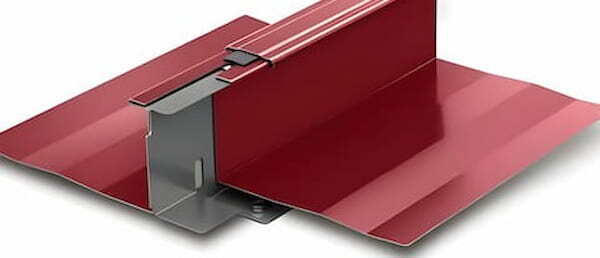
The Berridge Tee-Lock standing seam panel blends sleek architectural design with dependable structural integrity, pairing perfectly with OSHA-compliant non-penetrating anchors to keep crews safe on metal roofs.
The Berridge Tee-Lock Panel adds a modern touch to the company's standing seam lineup, featuring clean lines, concealed fasteners, and exceptional weather resistance. With a symmetrical profile measuring 2⅜ inches high and 18 inches wide, this system delivers both strength and architectural appeal. It's available in 22- and 24-gauge steel, as well as .032- and .040-inch aluminum, making it suitable for a wide range of roofing and fascia applications. See the Roof Anchor Compatibility Chart for Berridge Manufacturing Tee-Lock 22 Gauge and 24 Gauge Standing Seam Panels.
Each Tee-Lock panel uses a mechanically seamed, T-shaped batten cap that locks into place for a watertight seal. The seam design eliminates exposed fasteners, protecting the roof from leaks and ensuring long-term performance in demanding environments. Installers can choose between striated or smooth finishes, allowing the panel to blend seamlessly into modern residential, commercial, or institutional projects.
Tee-Lock panels can be fabricated in continuous lengths of up to 40 feet or roll-formed on-site using the Berridge TP-24 portable roll former. The continuous Tee-Lock Seam Cap complements the panel system, maintaining a consistent look while reinforcing its strength and durability. The result is a sleek, high-performance standing seam system that strikes a balance between aesthetic refinement and long-lasting protection.
Fall Protection For Tee-Lock Roofs
For 22- and 24-gauge steel Tee-Lock panels, the SSRA fall protection system offers the most secure and non-penetrating solution available.
The SSRA1 Standing Seam Roof Anchor attaches directly to the seams with six pairs of stainless steel set screws, creating a strong, 5,000-pound-rated tie-off point that does not compromise the watertight seal. Workers can expand this setup with SSRA2 Adjustable Roof Jack Adapters, which mount onto the anchors to support ten-foot wooden walkboards, creating a stable footing for installation and maintenance. For multi-worker applications, SSRA3 Anchor Plates link two SSRA1 anchors together to support a temporary horizontal lifeline system.
When permanent access is required, the Super Anchor 120-foot Permanent Standing Seam Horizontal Lifeline Kit provides a long-term safety solution. It mounts along the roof seams to create fixed tie-off points, ensuring quick and compliant access for inspection and service crews without penetrating the panels.
Aluminum Tee-Lock panels are not compatible with seam-mounted anchors due to the softer substrate. For those systems, the Ridge Pro Steep Assist Anchor is the safest non-penetrating alternative for roofs with slopes between 6:12 and 12:12. It hooks securely over the ridge and connects to a vertical lifeline before workers step onto the roof, ensuring a continuous tie-off from the ladder to the ridge and back down again.
By pairing Berridge Tee-Lock panels with compatible, non-penetrating fall protection systems such as the SSRA1, SSRA2, SSRA3, Super Anchor Permanent HLL Kit, or the Ridge Pro Steep Assist Anchor, contractors can preserve the integrity of the roof while maintaining complete OSHA and ANSI compliance on every job.
Zee-Lock Mechanical Panel

The Berridge Zee-Lock mechanical panel brings exceptional watertight strength and design flexibility, best paired with seam-mounted anchors that protect the roof and ensure full fall-arrest compliance.
The Berridge Zee-Lock Panel delivers strength, versatility, and architectural precision in one proven system. This mechanically-seamed panel features a 2-inch vertical rib that locks together for exceptional watertight performance. It is suitable for both residential and commercial applications where durability and clean aesthetics are most important. See the Roof Anchor Compatibility Chart for Berridge Manufacturing Zee-Lock 22 Gauge and 24 Gauge Standing Seam Panels.
Zee-Lock panels can be installed on straight or curved roof systems in continuous lengths up to 40 feet. The panels are available in 22- and 24-gauge steel, as well as .032- and .040-inch aluminum, and come standard in 16-inch widths. One of the most distinctive features of the Zee-Lock system is its optional Snap-On Batten cap, which gives the roof a bold, box-seam appearance while maintaining the same mechanical lock strength beneath. This combination of performance and design flexibility has made the Berridge Zee-Lock a preferred choice for architects and builders seeking long-term results with modern appeal.
Fall Protection For Zee-Lock Roofs
Curved Zee-Lock panels require special attention during both installation and maintenance.
A trained safety professional should inspect the roof and determine which anchorage methods are appropriate for curved roof systems. The following fall protection recommendations apply only to straight, non-curved Zee-Lock panel systems.
For 22- and 24-gauge steel Zee-Lock panels, the SSRA product line provides the most reliable non-penetrating safety solution available. The SSRA1 Standing Seam Roof Anchor clamps directly to the seams using twelve non-penetrating set screws, creating a 5,000-pound-rated tie-off point without drilling or damaging the roof. Crews can expand their setup with SSRA2 Adjustable Roof Jack Adapters, which mount on top of the anchors to hold ten-foot walkboards and provide stable footing on steep roof areas. For multi-worker setups, SSRA3 Anchor Plates connect two SSRA1 anchors to support temporary horizontal lifelines.
When ongoing maintenance is required, the Super Anchor 120-foot Permanent Standing Seam Horizontal Lifeline Kit provides fixed tie-off points that remain in place for future access. This system enables safe and efficient work while maintaining the watertight integrity that makes the Zee-Lock panel so reliable.
Aluminum Zee-Lock panels, as well as panels that include the optional Snap-On Batten cap, are not compatible with seam-mounted anchors because the softer substrate and cover design prevent secure clamping. For these systems, the Ridge Pro Steep Assist Anchor is the best choice for roof slopes between 6:12 and 12:12. It is installed from the ladder using a 16-foot extension pole, which hooks over the ridge to create a secure tie-off point before anyone steps onto the roof. This approach keeps workers tied off at all times, maintaining the roof's clean appearance and ensuring long-term performance.
By pairing Berridge Zee-Lock panels with the proper non-penetrating systems, contractors can ensure complete fall protection without compromising the structure or aesthetics of the roof system.
Double-Lock Zee-Lock Mechanical Panel
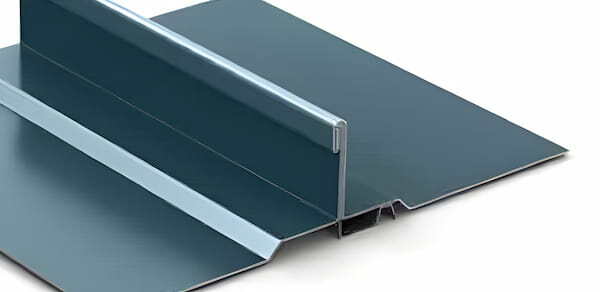
Berridge Double-Lock Zee-Lock panels deliver unmatched durability through a 180-degree seam connection, requiring non-penetrating fall protection that supports safety while preserving structural performance.
The Berridge Double-Lock Zee-Lock Panel represents the highest standard of precision and durability in standing seam metal roofing. This 2-inch, 180-degree mechanically seamed panel combines modern design with exceptional structural strength. With a 16-inch coverage width and continuous lengths up to 40 feet, the Double-Lock Zee-Lock performs equally well on roofs and fascia applications over both open framing and solid decking. See the Roof Anchor Compatibility Chart for Berridge Manufacturing Double-Lock Zee-Lockand 24 Gauge Standing Seam Panels.
Available in 24-gauge steel and 0.032- or 0.040-inch aluminum, this panel is perfect for projects that require watertight performance and a refined architectural finish. Installers can produce the panels on-site using the Berridge SP-21 Roll Former and finish the seams in a single pass with the Berridge Double-Lock Zee-Lock Seamer. The result is a clean, secure connection that locks out moisture and ensures decades of reliable performance.
Architects appreciate the flexibility of this system. Workers can install it with a flat pan for a minimalist appearance or specify it with striations for visual depth and reduced oil canning. The Double-Lock Zee-Lock has become a popular choice for both residential and commercial projects that require modern aesthetics combined with long-term performance.
Fall Protection For Double-Lock Zee-Lock Roofs
Working safely on Double-Lock Zee-Lock roofs requires non-penetrating systems that protect the seams while keeping workers fully tied off at all times.
For 24-gauge steel panels, the SSRA fall protection lineup provides a reliable and OSHA-compliant solution. The SSRA1 Standing Seam Roof Anchor attaches directly to the seams with twelve stainless steel set screws, creating a 5,000-pound-rated tie-off point without drilling or deforming the metal. Crews can expand this setup with SSRA2 Adjustable Roof Jack Adapters, which mount on top of the anchors to hold ten-foot wooden walkboards. These adapters provide a stable footing and safe access on steep sections of the roof. For larger projects, SSRA3 Anchor Plates connect between two SSRA1 anchors to create anchor points for temporary horizontal lifelines.
When permanent access is required, the Super Anchor 120-foot Permanent Standing Seam Horizontal Lifeline Kit provides a durable solution that remains ready for use year-round. It installs to the seams with non-penetrating seam clamps, providing inspection and maintenance teams with safe access to the roof.
For aluminum Double-Lock Zee-Lock panels, seam-mounted anchors are not recommended because the softer substrate cannot handle the possible impact loads safely. On roofs with slopes between 6:12 and 12:12, the Ridge Pro Steep Assist Anchor is the best alternative. It is installed from the ladder using a 16-foot extension pole, which hooks securely over the ridge to create a tie-off point before workers step onto the roof. This approach keeps crews 100 percent tied off from the ladder to the ridge and back down again, while maintaining the roof's clean appearance and long-term integrity.
By pairing Berridge Double-Lock Zee-Lock panels with compatible non-penetrating systems—such as the SSRA1, SSRA2, SSRA3, Super Anchor HLL Kit, or the Ridge Pro Steep Assist Anchor—contractors can achieve total safety compliance while preserving the watertight strength that defines the Berridge Double-Lock system.
Batten Seam Panel
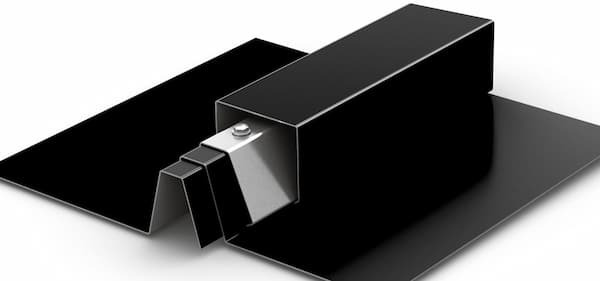
The Berridge Batten Seam roof system features bold box seams and hidden fasteners, making ridge-mounted anchors the safest choice for long-term worker protection and roof preservation.
The Berridge Batten Seam Panel system creates bold architectural lines and a distinctive visual rhythm that elevates both modern and traditional designs, enhancing their aesthetic appeal. This two-part system combines the Deep-Vee panel with square snap-on battens to form wide, clean seams that stand out on any structure. The panels are 24-gauge steel, measure 16 inches in width, and feature a box seam that is 2 inches wide and 1¾ inches tall. See the Roof Anchor Compatibility Chart for Berridge Batten Seam Panel.
This system can be installed over open framing or solid sheathing, giving architects and contractors flexibility for both roofing and wall applications. The snap-on batten cap conceals fasteners and creates a refined surface while maintaining a watertight connection. With continuous lengths available up to 40 feet and the option for on-site forming using the Berridge BP-21 Roll Former, installation remains efficient and precise.
Each panel attaches with batten clips spaced at 20 inches on center, providing secure fastening across the entire roof or wall. Batten end caps at the panel base complete the watertight design, ensuring long-term protection and performance. The Batten Seam system blends form and function, making it ideal for residential roofs, commercial facades, and architectural siding where strong lines and lasting beauty are priorities.
Fall Protection For Batten Seam Roofs
Because the Batten Seam system uses a snap-on cover design, it does not provide an exposed rib or structural seam suitable for clamp-on anchors.
Installing seam-mounted devices could damage the batten covers or compromise their ability to support a full impact load. For this reason, non-penetrating ridge-mounted anchors are the safest and most effective option.
On roofs with slopes between 6:12 and 12:12, the Ridge Pro Steep Assist Anchor provides a reliable tie-off point without drilling or clamping to the panels. It is installed from the ladder using a 16-foot extension pole, which hooks securely over the ridge to establish an anchor point before the worker steps onto the roof. This assembly ensures a full tie-off from the ladder to the ridge and back down again, keeping crews safe while maintaining the roof's watertight integrity.
By pairing the Berridge Batten Seam Panel system with non-penetrating safety solutions such as the Ridge Pro Steep Assist Anchor, contractors can protect both workers and the roof itself. This approach ensures compliance, safety, and long-term performance on every Batten Seam installation.
Standing Seam Roof Anchor Compatibility For Berridge 24 Gauge Panels
| Cee-Lock 24 Ga. | Tee-Panel | High Seam Tee-Panel | Tee-Lock 24 Ga. | Zee-Lock 24 Ga. | Double-Lock Zee-Lock 24 Ga. | Batten Seam Panel | |
|---|---|---|---|---|---|---|---|
SSRA 1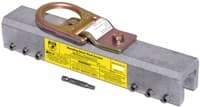 |
NO | NO | NO | NO | NO | NO | NO |
SSRA1 Nylon Tip |
YES | NO | NO | YES | YES | YES | NO |
SSRA2 Roof Jack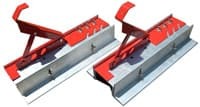 |
YES | NO | NO | YES | YES | YES | NO |
SSRA3 Anchor Plate |
YES | NO | NO | YES | YES | YES | NO |
The Ridge Pro |
YES | YES | YES | YES | YES | YES | YES |
Standing Seam Roof Anchor Compatibility For Berridge 22 Gauge Panels
| Cee-Lock 22 Ga. | Tee-Lock 22 Ga. | Zee-Lock 24 Ga. | |
|---|---|---|---|
SSRA 1 |
YES | YES | YES |
SSRA1 Nylon Tip |
YES | YES | YES |
SSRA2 Roof Jack |
YES | YES | YES |
SSRA3 Anchor Plate |
YES | YES | YES |
The Ridge Pro |
YES | YES | YES |
Contact Us For More Fall Protection Information
For further details on roofing solutions and fall protection systems, contact us at 863-703-4522 or www.StandingSeamRoofAnchor.com. Let's work together to make your roofing projects safe, beautiful, and built to last. For more safety tips, refer to OSHA's 48-page Fall Protection Manual. Once you have determined the most suitable anchors for your roof system, download our free Anchor Inspection Form.
Safety Tips For Standing Seam Roofs
Ensure Proper Footwear for Stability
Footwear with strong traction and good ankle support helps roofers stay steady on smooth metal panels. The right pair prevents slips on damp or dusty surfaces and reduces fatigue after long hours on steep slopes. With solid footing comes safety and confidence at height.
Develop OSHA-Compliant Safety Plans
A strong plan removes confusion and keeps everyone accountable. OSHA-compliant safety plans should outline the location of tie-offs, the procedures for handling rescues, and the person responsible for each task. When every worker understands the plan, it turns emergencies into rehearsed responses instead of panic. Preparation makes all the difference once work begins.
Use Specialized Anchor Systems for Standing Seam Roofs
Standing seam panels require anchors that respect the roof's design and aesthetics. Non-penetrating systems, like the SSRA1 clamp, directly attach to the seams without breaking the surface or voiding warranties. This method keeps the roof watertight while giving workers reliable tie-off points. Avoid anchors that depend on clip placement since locating hidden clips under finished panels is nearly impossible.
Encourage the Use of Trauma Straps
Even after a fall is stopped, danger increases quickly when blood flow is cut off. Trauma straps allow a worker hanging in a harness to stand and relieve leg pressure until help arrives. They are small, affordable, and vital for survival. Every harness on site should include them as standard equipment, not as an afterthought.
Set Up Protective Guardrail Barriers for Work Zones
Guardrails act as silent sentinels on busy job sites. Once installed, they stop most falls before they start by keeping workers clear of edges, skylights, and openings. They also help define the workspace and remind crews where risk zones begin. It's one of the simplest ways to prevent injuries without slowing down progress.
Equip Workers with High-Quality Safety Gear
Reliable gear turns safety from a rule into a habit. A snug-fitting harness, a dependable lifeline, and a well-maintained lanyard form the foundation of every roofer's PFAS. When workers know their gear will hold, they move with confidence and focus on the task at hand. OSHA's 2025 update requires that all fall protection equipment fit the individual user, making inspection and proper sizing more critical than ever.
Consult Experts for Curved Metal Panels
Curved roofs add architectural beauty but bring their own safety challenges. The radius and slope can affect how anchors attach to the seams. Before starting work, call in a trained fall protection professional to inspect and plan the setup. This extra step protects workers and preserves the craftsmanship that makes curved roofs stand out.
Prioritize Ladder Safety Training
Most roofing accidents don't happen on the roof; they happen on the way up. Always inspect ladders for wear, place them on firm ground, and follow the 4-to-1 rule for proper angle. Maintaining three points of contact at all times prevents countless injuries. Regular ladder safety training ensures these habits become second nature to every crew member.
Promote a Culture of Safety
Safety thrives in open conversations about workplace dangers. When teams share lessons from close calls, speak up about risks, and encourage accountability, awareness spreads across the site. Crews that prioritize safety build habits that last beyond a single project. That shared mindset turns safety from a checklist into a daily practice.
Install Permanent Roof Anchor Systems
Permanent anchors give workers a trusted connection point every time they return to a roof. They remove the uncertainty of temporary setups and ensure quick tie-off access for inspections or maintenance. Once installed, these anchors blend into the structure and provide years of reliable service. They're one of the smartest investments a building owner can make for long-term safety.
Disclaimer
The views, recommendations, and information presented in this blog are solely those of the author and do not necessarily reflect the opinions or positions of the featured panel manufacturer, its brands, subsidiaries, or parent companies. Customers are strongly encouraged to contact the roof panel manufacturer directly for inquiries regarding fall protection compatibility with their products and to address any potential warranty issues that may arise after installing our products.

